November 1, 2011
For a downloadable version, click the following:
THE FUTURE GUIDES THE PRESENT; THE DEMOGRAPHIC MAP VERSUS THE HELP WANTED SECTION OF THE WANT ADS: What will tomorrow’s today look like demographically by 2050?
The editor of this newsletter just finished writing a letter of support to the City of Livonia’s Planning Commission concerning the private sector construction of senior citizen housing. I pointed out that the long heralded entry of Baby Boomers into retirement has finally begun in earnest.
DECEPTION OF PERCEPTION: THE LATEST REPORT ON UNEMPLOYMENT
(July 2011)
www.econnewsletter.com/jul102011
…baby-boomers (born 1946 - 1964) are beginning to retire; some at age 65, but many of them at much younger ages. The inherent problem with people retiring, even at 65, is that many of those people will live for another 20-25 years. The increased longevity is a wonderful thing (we're all for it!!!), but it has to be supported. There's no reason why people shouldn't continue to work well into their 'golden years'. It's all a matter of matching people with the suitable job.
A pre-shock has already occurred with the inception of the current economic malaise, The Great Recession. Among the miserable data streaming out at us are two series, early retirements and permanent disability claims. They have literally gone through the roof. We might call them the extremely discouraged workers with no hope of ever finding a job. I have had lunch with a few of them lately! They are for real and they in general are very well educated and in the past have held very responsible jobs.
Disability---
The U.S. economy has been experiencing significant increases in early retirements and claimants being granting permanent disability status. We here at the New Economic Paradigm Associates have coined the term “Very Discouraged Workers.” These two groups also reduce the labor force participation rate and obscure the seriousness of the unemployment problem.
IF THE UNEMPLOYMENT RATE IS REALLY FALLING, WHY ARE SO MANY PEOPLE STILL OUT OF WORK? THE DEVIL IS IN THE DETAILS
www.econnewsletter.com/feb062011
www.ssa.gov/policy/docs/statcomps
All Social Security disabled beneficiaries in current-payment status, December 1970–2009
The number of disabled workers grew steadily until 1978, declined slightly until 1983, started to increase again in 1984, and began to increase more rapidly beginning in 1990. The growth in the 1980s and 1990s was the result of demographic changes, a recession, and legislative changes. The number of disabled adult children has grown slightly, and the number of disabled widow(er)s has remained fairly level. In December 2009, about 7.8 million disabled workers, just under 921,000 disabled adult children, and over 236,000 disabled widow(er)s received disability benefits.
A stubborn and severe recession is exacerbating the dismal job outlook and causing accelerated early retirements from the labor force, seeking long term disability status, and an increasing reality of very long duration unemployment.
HERE WE GO AGAIN
www.econnewsletter.com/sep232010
Lack of jobs is now THE major problem in the U.S. economy. A stubborn and severe recession is exacerbating the dismal job outlook and causing accelerated early retirements from the labor force, record numbers seeking long term disability status, and an increasing number of very long duration unemployed. The U.S. is beginning to look a lot like Europe!
www.ssa.gov/policy/docs/statcomps

Of immediate interest are the early retirement numbers. The period from 1946 through 1964 was one of very high birth rates. The first four years of that group have already reached 62 and are eligible to apply for early retirement and Social Security benefits and Medicare (age 64 and 8 months, earlier, if you are on Disability). A relatively large number have already done so as the above graph clearly shows. Now the full onslaught is beginning as those born in 1946 have reached the ripe old age of 65.
LA Times – May 24, 2009 (Mike Dorning)
articles.latimes.com/2009/may/24/nation/na-retirement24
Instead of seeing older workers staying on the job longer as the economy has worsened, the Social Security system is reporting a major surge in early retirement claims that could have implications for the financial security of millions of baby boomers.
Since the current federal fiscal year began Oct. 1, claims have been running 25% ahead of last year, compared with the 15% increase that had been projected as the post-World War II generation reaches eligibility for early retirement, according to Stephen C. Goss, chief actuary for the Social Security Administration.
It is happening at the worst of times, in the midst of the economic and financial malaise now being termed the Great Recession. The pressure on government will rapidly mount to provide for the senior citizens, an age group that is less able to cope for themselves. If the pattern of increasing government involvement for the low income members of our population is indicative of what will happen in the area of government intervention into senior citizen welfare concerns (such as Medicare), a flood of programs will begin to flow from the federal and state legislatures that will swamp an already over-burdened municipal governments. The stupidity of such programs as 30 years of work and out combined with increasing longevity will become very clear.
When the experience of these events and the resulting challenges do become clear, consumer spending may take a serious hit as the public begins to realize that retirement’s ‘golden years’, are ONLY gold if the retirees have accumulated enough wealth to see them through and they can afford reasonable health care.
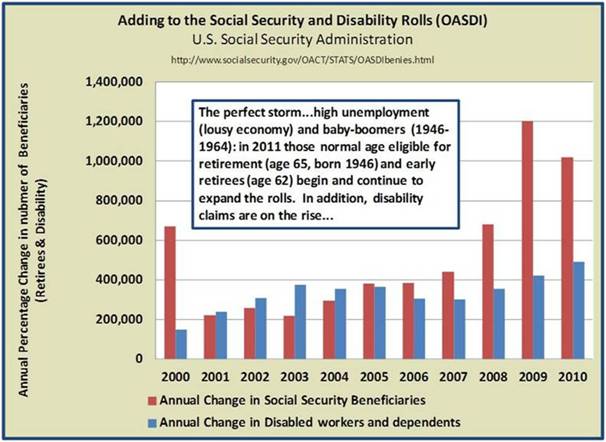
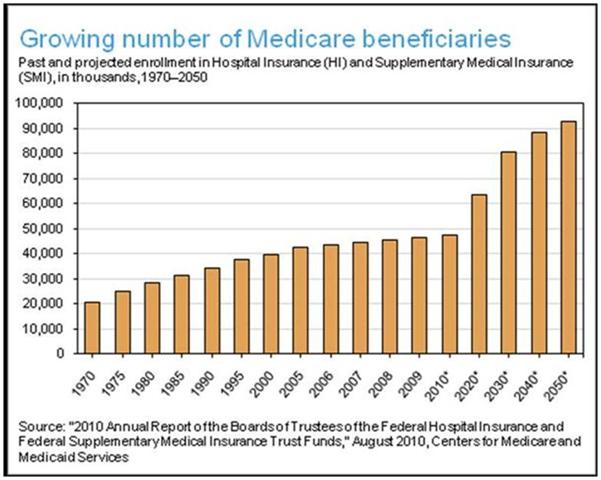
www.publicagenda.org/charts/growing–number–medicare

Department of Health and Human Services – (CMS) Centers for Medicare and Medicaid Services
FYI - Nearly a third of the U.S. population is receiving some degree of government financed healthcare…
I am pleased to present the Centers for Medicare & Medicaid Services’ (CMS) fiscal year (FY) 2011 performance budget. Our programs will touch the lives of almost 102 million Medicare, Medicaid, and Children’s Health Insurance Program (CHIP) beneficiaries in FY 2011.
Charlene Frizzera - Acting Administrator (CMS) Centers for Medicare and Medicaid Services
The Centers for Medicare & Medicaid Services (CMS) oversees three of the nation’s largest health care programs: Medicare, Medicaid, and the Children’s Health Insurance Program (CHIP). CMS is the largest purchaser of health care in the United States and expects to serve almost 102 million beneficiaries in FY 2011. In FY 2009, CMS spent $782 billion on benefits and other costs.
For more than 40 years, Medicare and Medicaid have helped pay the medical bills of millions of older and low-income Americans, providing them with reliable health benefits. We expect to serve almost 102 million beneficiaries in FY 2011, roughly one in three Americans. Medicare and Medicaid combined pay about one-third of the Nation’s health expenditures.
Medicare
Established in 1965, the Medicare program provides hospital and supplemental medical insurance to Americans age 65 and older and to disabled persons, including those with end-stage renal disease. The program was expanded in 2003 to include a voluntary prescription drug benefit. Medicare enrollment has increased from 19 million in 1966 to over 48 million beneficiaries in 2011.
Medicaid

Data Source: *CMS Office of the Actuary estimate. 17 States have reported a total of 15,805,766 beneficiaries enrolled. CMS will continue to work with States in order to obtain full reports from every State.
Children's Health Insurance Program (CHIP)
In 2008, eleven years after CHIP was created, States reported that 7.4 million children were enrolled in the program. The Children’s Health Insurance Program Reauthorization Act of 2009 (P.L. 111-3) reauthorized CHIP from April 2009 through September 30, 2013 and increased funding by $44 billion through 2013 to maintain State programs and to cover more insured children. In response to the funding increase, CMS revised a performance measure to decrease the number of uninsured children by working with States to enroll children in CHIP. CMS exceeded its FY 2008 target to increase CHIP enrollment by 2 percent over the FY 2006 baseline enrollment figure. The FY 2006 baseline was 6,600,000 and our FY 2008 result was 7,368,479, an increase of over 11 percent.
POLITICIANS BEWARE! Absentee ballots are beginning to change the outcomes of elections. Senior citizens voting in elections show a much larger percentage than do other groups.
SENIOR CITIZENS BEWARE! You may have heard of what appears to be a growing tendency for election fraud in regard to the counting of absentee ballots. It is equally critical as to when the absentee ballots are counted are reported as the running counts of partial election results can influence the desire of those voting later on election day to actually vote and for whom to vote. Counting absentee ballots as an AFERTHOUGHT may effectively influence the election outcomes against the preferences of the senior citizens.
It should be also noted that many demographers speak of a DEMOGRAPHIC WINTER (www.demographicwinter.com). The baby boomers (born from 1946-64) were followed by what I prefer to call a BIRTH DEARTH. This occurred from 1965 to about 1983 with the age of ZPG or zero population growth advocates. It is a problem not only here in the U.S. of A. but in places like Western Europe at the present time. Just below are current reproduction rates, some of which of imploding populations and a rise in immigration rates to fill the void. This often leads to culture shocks as immigrants do not share the same cultural values of the populations of the countries into which the immigrants are migrating.
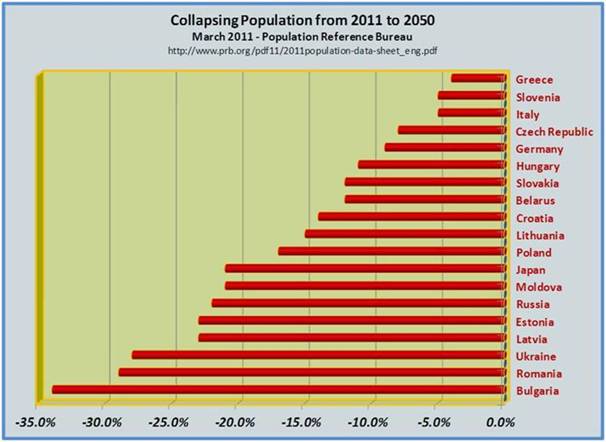
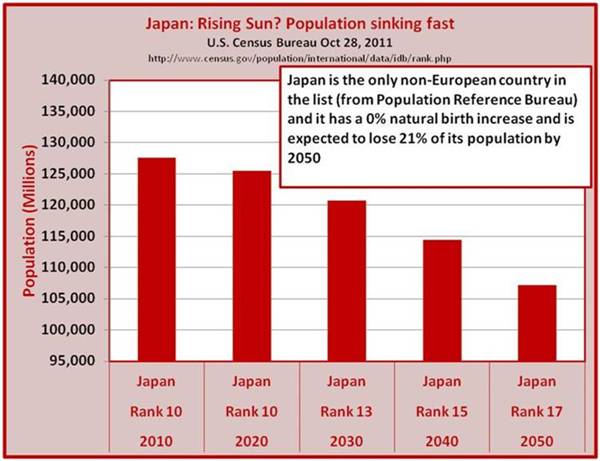
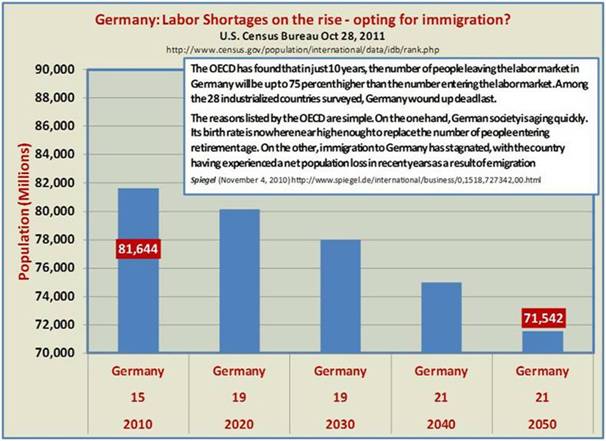
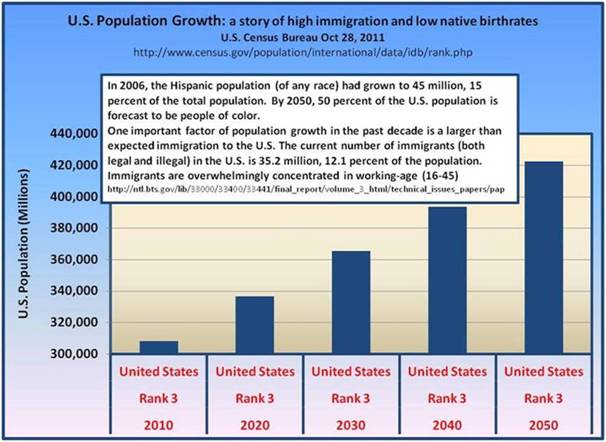
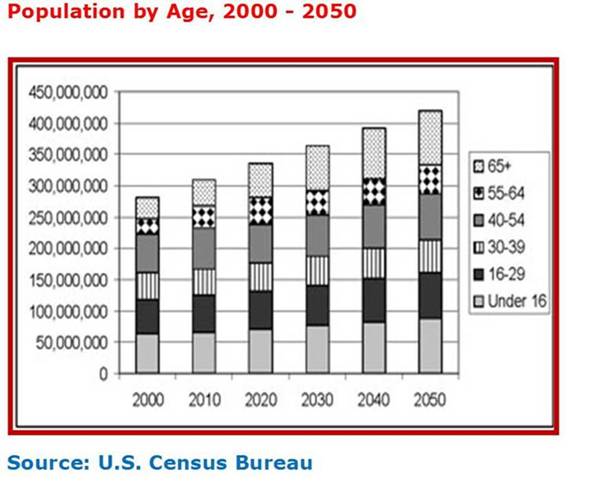
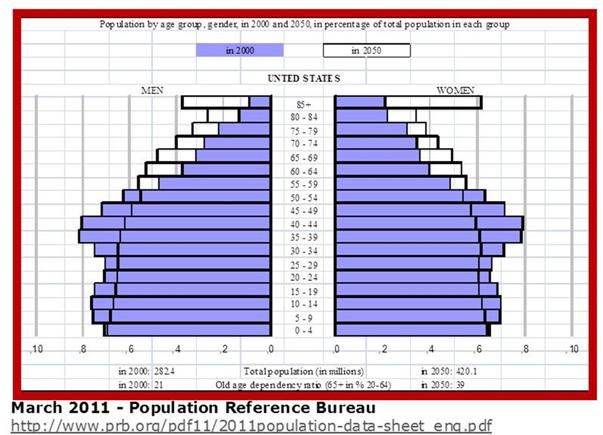
March 2011 - Population Reference Bureau
www.prb.org/pdf11/2011population-data-sheet#046;pdf
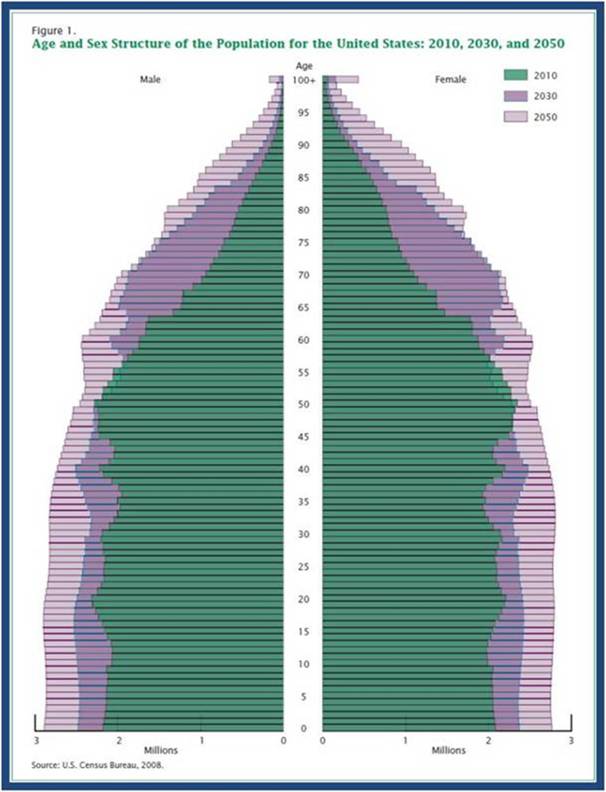
Between 2010 and 2050, the U.S. population is projected to grow from 310 million to 439 million, an increase of 42 percent. The nation will also become more racially and ethnically diverse, with the aggregate minority population projected to become the majority in 2042.* The population is also expected to become much older, with nearly one in five U.S. residents aged 65 and older in 2030.
THE NEXT FOUR DECADES
The Older Population in the United States:
- 2010 to 2050
- Population Estimates and Projections (Current Population Reports)
- U.S. Department of Commerce
- Economics and Statistics Administration
- U.S. CENSUS BUREAU
- Issued May 2010
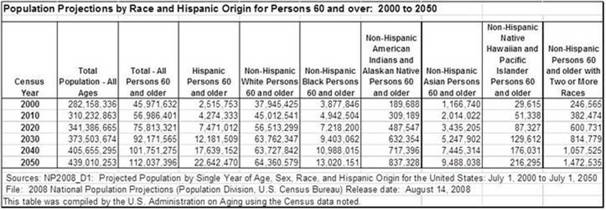
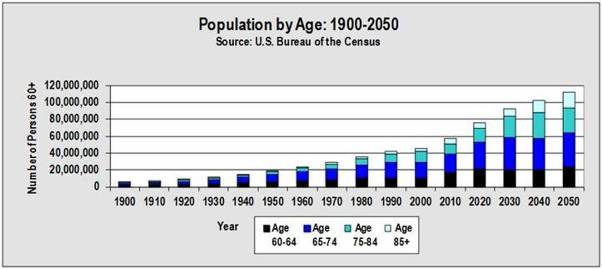
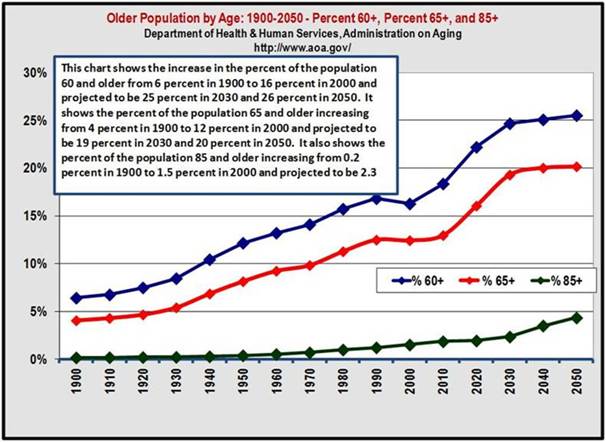
Recall the massive change in job outlook(s) back in the Post WWII days as the Baby Boom was occurring. Doctors were switching from Gerontology to OB/GYN and then Pediatrics. Schools of Education were exploding with growth as many saw the teaching field expand from vocation to profession. The housing industry flourished, with baby-sitters became a necessity and so on.
Now we are seeing a major reversal as the population ages. There is a serious problem however. The current productive resources base (labor, debt and equity capital, entrepreneurship and land) must support the entire population. If the retirees have saved and accumulated significant wealth in pensions, etc., there must be a transfer from those productive resources currently employed to those becoming retirees and not actively engaged in the production process – other than as capitalists supplying their retirement assets. Even here, if the retirees desire to dis-accumulate their wealth to raise their material level of goods and services, it is up to the active resource base and the public, participating in the production process, to buy the assets and pay the taxes to support such programs as Social Security and Medicare. Consider the burden of illegal immigrants into this country. The pressure is great to give them the same rights and benefits as those who legally migrated. States like Arizona and California are reeling under the fiscal burdens to do so. You can argue until Hell freezes over about the moral merits and demerits of doing so. The emerging picture is clear. It points to the consequences of ‘doing so’ and the ever-increasing strain on the already near-bankrupt state and local governments.
CONNECT THE DOTS.
YESTERDAY’S FUTURE IS TODAY’S PRESENT.


